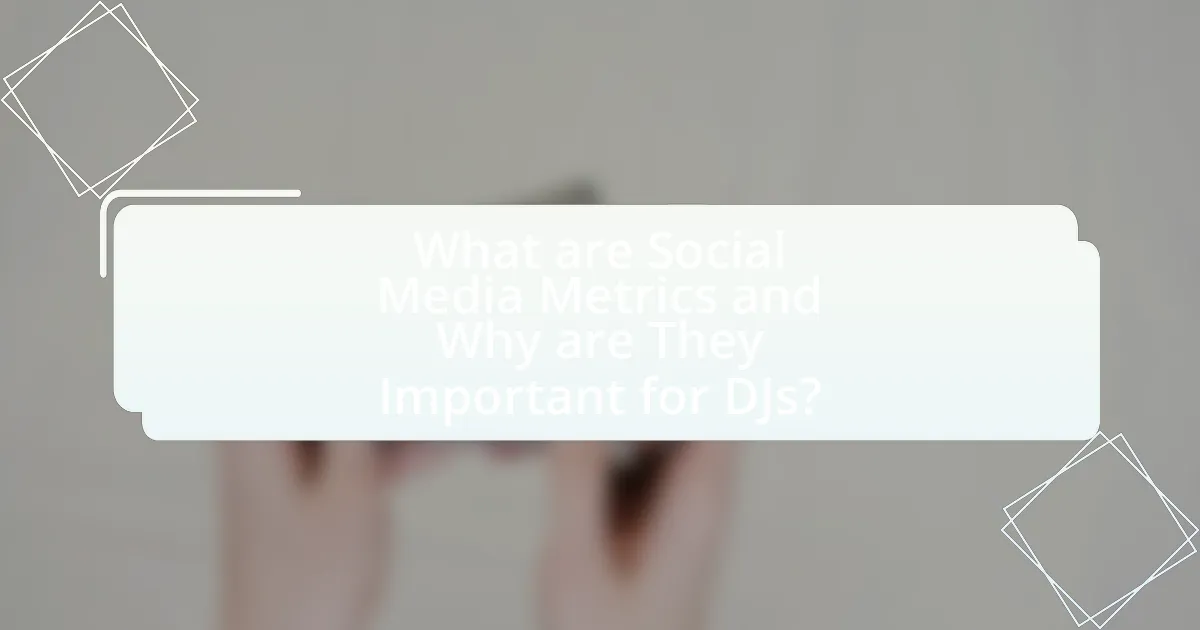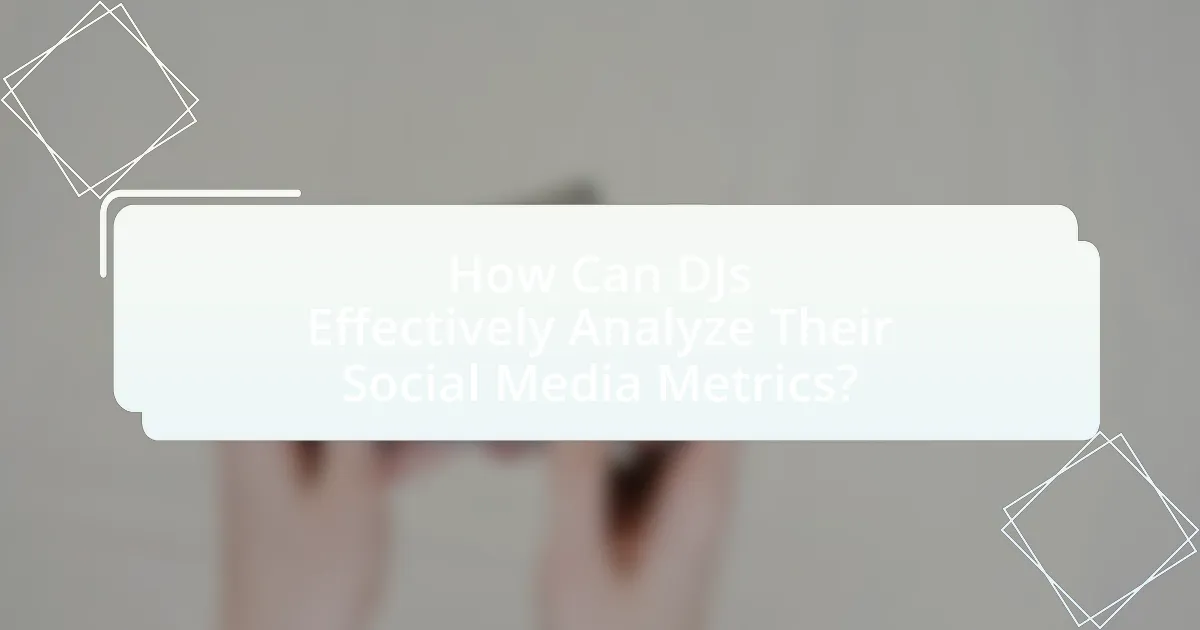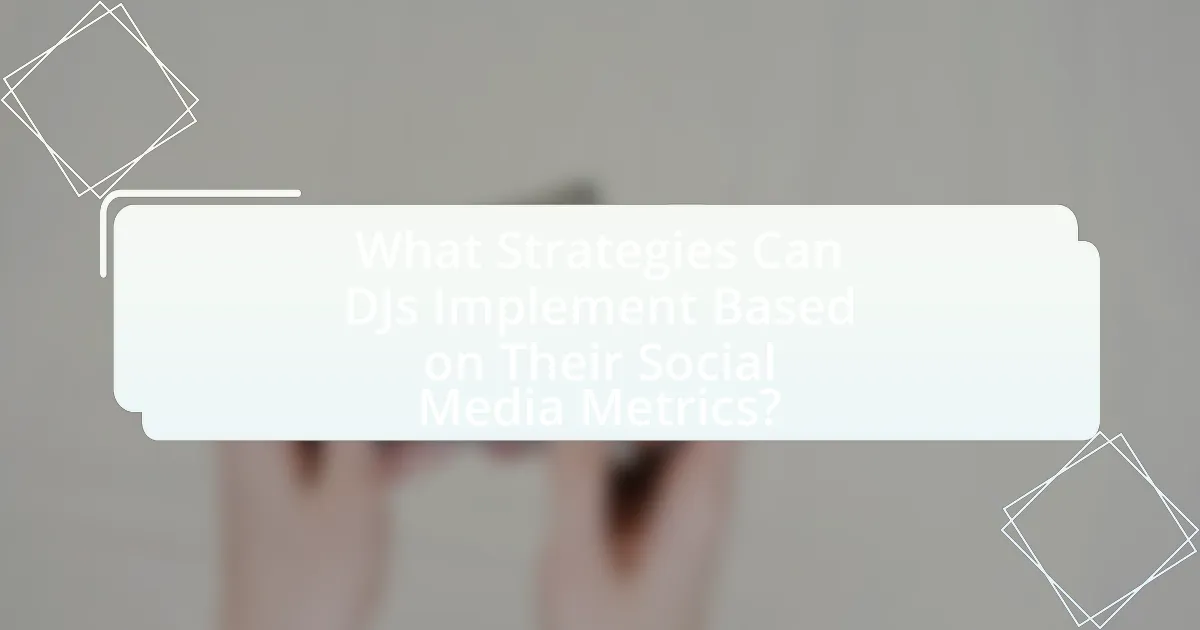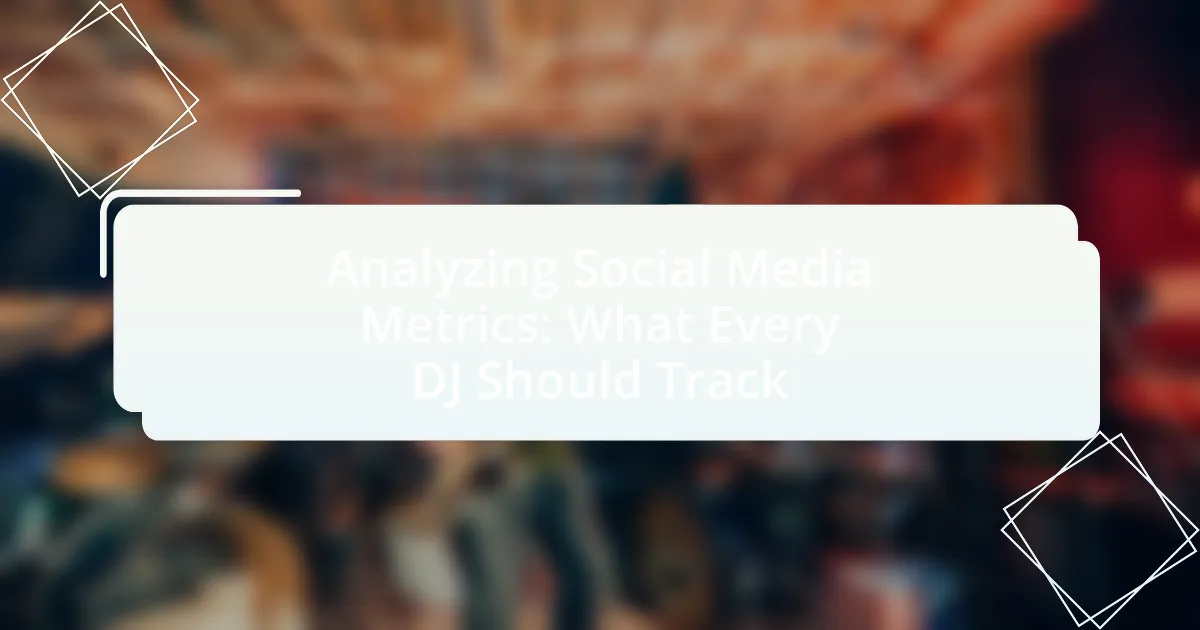The article focuses on the significance of social media metrics for DJs, emphasizing how these quantitative measurements can enhance their career by improving visibility, audience engagement, and booking opportunities. It outlines specific metrics that DJs should track, such as audience engagement, follower growth, and streaming statistics, to gauge their success and refine marketing strategies. Additionally, the article discusses the importance of understanding engagement metrics, reach, impressions, and the role of analytics tools in interpreting data. By leveraging these insights, DJs can optimize their content strategy, increase engagement, and ultimately achieve greater success in the music industry.

What are Social Media Metrics and Why are They Important for DJs?
Social media metrics are quantitative measurements that evaluate the performance and engagement of content shared on social media platforms. For DJs, these metrics are crucial as they provide insights into audience reach, engagement levels, and overall effectiveness of promotional strategies. For instance, metrics such as likes, shares, comments, and follower growth can indicate how well a DJ’s brand resonates with fans, helping to refine marketing efforts and enhance audience connection. Additionally, a study by Hootsuite found that 73% of marketers believe that social media marketing has been effective for their business, underscoring the importance of tracking these metrics for success in the music industry.
How do Social Media Metrics Impact a DJ’s Career?
Social media metrics significantly impact a DJ’s career by influencing their visibility, audience engagement, and booking opportunities. High engagement rates, such as likes, shares, and comments, indicate a strong connection with fans, which can lead to increased follower counts and greater exposure. For instance, a DJ with a high number of followers on platforms like Instagram or TikTok is more likely to attract the attention of event organizers and promoters, as these metrics serve as indicators of popularity and marketability. Additionally, analytics tools can provide insights into audience demographics and preferences, allowing DJs to tailor their content and performances to better meet the expectations of their fan base. This strategic approach can enhance a DJ’s reputation and lead to more lucrative gigs and collaborations.
What specific metrics should DJs focus on to gauge their success?
DJs should focus on metrics such as audience engagement, follower growth, and streaming statistics to gauge their success. Audience engagement can be measured through likes, shares, comments, and overall interaction on social media platforms, indicating how well their content resonates with listeners. Follower growth reflects the increasing popularity and reach of the DJ, showing how many new fans are attracted over time. Streaming statistics, including the number of plays and listener demographics on platforms like Spotify or SoundCloud, provide insights into the DJ’s music performance and audience preferences. These metrics collectively offer a comprehensive view of a DJ’s impact and success in the music industry.
How can understanding these metrics influence a DJ’s marketing strategy?
Understanding social media metrics allows a DJ to tailor their marketing strategy effectively by identifying audience preferences and engagement patterns. For instance, analyzing metrics such as likes, shares, and comments can reveal which types of content resonate most with followers, enabling the DJ to create more targeted promotional materials. Additionally, tracking follower growth and demographic data helps in segmenting the audience, allowing for personalized marketing campaigns that can increase ticket sales and event attendance. Research indicates that DJs who utilize data-driven strategies see a 30% increase in engagement rates, demonstrating the tangible benefits of understanding these metrics.
What Types of Social Media Metrics Should DJs Track?
DJs should track engagement metrics, follower growth, reach, impressions, and conversion rates on social media. Engagement metrics, such as likes, shares, and comments, indicate how well content resonates with the audience, while follower growth reflects the effectiveness of promotional strategies. Reach and impressions provide insights into how many users see posts, essential for understanding visibility. Conversion rates measure the effectiveness of social media in driving actions, such as ticket sales or streaming plays. Tracking these metrics allows DJs to refine their marketing strategies and enhance audience interaction, ultimately leading to increased success in their careers.
What are Engagement Metrics and why are they crucial for DJs?
Engagement metrics are quantifiable data points that measure how audiences interact with a DJ’s content on social media platforms, including likes, shares, comments, and overall reach. These metrics are crucial for DJs because they provide insights into audience preferences and behaviors, enabling DJs to tailor their content and marketing strategies effectively. For instance, a study by Hootsuite found that posts with higher engagement rates lead to increased visibility and follower growth, which is essential for a DJ’s brand development and audience connection. By analyzing these metrics, DJs can optimize their performances and promotional efforts, ensuring they resonate with their target audience.
How do Reach and Impressions differ, and why do they matter?
Reach refers to the total number of unique users who see a piece of content, while impressions indicate the total number of times that content is displayed, regardless of whether it was clicked or not. Understanding the difference is crucial for DJs analyzing social media metrics because reach provides insight into the breadth of audience exposure, whereas impressions reveal how often that content is viewed, which can indicate engagement levels. For instance, if a post has a reach of 1,000 but 5,000 impressions, it suggests that users are seeing the content multiple times, highlighting its potential impact and effectiveness in engaging the audience.
What Role do Follower Growth Metrics play in a DJ’s online presence?
Follower growth metrics are crucial for a DJ’s online presence as they indicate audience engagement and popularity. A steady increase in followers reflects the DJ’s ability to attract and retain listeners, which is essential for building a brand in the competitive music industry. For instance, a study by Hootsuite found that brands with a strong social media following experience 28% more engagement, highlighting the importance of follower growth in enhancing visibility and reach. Additionally, follower growth can influence booking opportunities, as promoters often consider social media presence when selecting artists for events.

How Can DJs Effectively Analyze Their Social Media Metrics?
DJs can effectively analyze their social media metrics by utilizing analytics tools provided by platforms like Facebook, Instagram, and Twitter to track engagement, reach, and audience demographics. These tools offer insights such as likes, shares, comments, and follower growth, which help DJs understand what content resonates with their audience. For instance, a study by Hootsuite found that posts with videos receive 48% more engagement than those without, highlighting the importance of content type in audience interaction. By regularly reviewing these metrics, DJs can adjust their content strategy to enhance audience engagement and grow their fan base.
What Tools are Available for Tracking Social Media Metrics?
Several tools are available for tracking social media metrics, including Hootsuite, Sprout Social, Buffer, and Google Analytics. Hootsuite allows users to monitor multiple social media accounts and provides analytics on engagement and reach. Sprout Social offers comprehensive reporting features that analyze audience demographics and content performance. Buffer focuses on scheduling posts while providing insights into post engagement and audience interaction. Google Analytics tracks website traffic from social media platforms, offering data on user behavior and conversion rates. These tools are widely used in the industry, demonstrating their effectiveness in measuring social media performance.
How do analytics tools differ across various social media platforms?
Analytics tools differ across various social media platforms primarily in the metrics they provide and the depth of insights available. For instance, Facebook’s analytics tools offer detailed demographic data, engagement metrics, and ad performance insights, allowing users to track audience behavior and campaign effectiveness. In contrast, Twitter’s analytics focus on tweet impressions, engagement rates, and follower growth, providing a more real-time view of content performance. Instagram’s analytics emphasize visual content engagement, such as likes, comments, and story interactions, catering to a visually-driven audience. Additionally, LinkedIn’s analytics tools are tailored for professional networking, offering insights into post reach and audience demographics relevant to business contexts. These differences reflect the unique user bases and content types of each platform, influencing how DJs and marketers track and analyze their social media performance.
What are the benefits of using third-party analytics tools for DJs?
Using third-party analytics tools provides DJs with enhanced insights into their audience engagement and performance metrics. These tools allow DJs to track key performance indicators such as follower growth, engagement rates, and audience demographics, enabling them to tailor their content and marketing strategies effectively. For instance, analytics can reveal which tracks resonate most with listeners, guiding DJs in their set selections and promotional efforts. Additionally, third-party tools often aggregate data from multiple platforms, offering a comprehensive view of a DJ’s online presence and helping to identify trends over time. This data-driven approach can lead to improved audience retention and increased bookings, as DJs can make informed decisions based on concrete evidence of their performance.
How Can DJs Interpret Their Social Media Data?
DJs can interpret their social media data by analyzing engagement metrics such as likes, shares, comments, and follower growth. These metrics provide insights into audience preferences and the effectiveness of content. For instance, a high number of shares on a specific post indicates that the content resonates well with the audience, suggesting a successful connection with fans. Additionally, tracking follower growth over time can reveal the impact of promotional strategies or events, helping DJs adjust their marketing efforts accordingly. By utilizing analytics tools provided by platforms like Instagram and Facebook, DJs can gather detailed reports that highlight which posts perform best, allowing for data-driven decisions in future content creation.
What patterns should DJs look for in their engagement metrics?
DJs should look for patterns in audience interaction, such as likes, shares, comments, and overall reach. Analyzing these metrics reveals which content resonates most with listeners, indicating their preferences and engagement levels. For instance, a spike in comments during a specific post may suggest that the content sparked interest or conversation, while consistent likes on certain tracks can highlight popular music choices. Additionally, tracking the timing of engagement can help DJs identify optimal posting times, as engagement often varies based on when followers are most active.
How can DJs use data to refine their content strategy?
DJs can use data to refine their content strategy by analyzing social media metrics such as engagement rates, audience demographics, and content performance. By tracking these metrics, DJs can identify which types of posts resonate most with their audience, allowing them to tailor their content to better meet listener preferences. For instance, a study by Hootsuite found that posts with videos receive 48% more engagement than those without, indicating that incorporating more video content could enhance audience interaction. Additionally, understanding audience demographics helps DJs create targeted content that appeals to specific groups, ultimately leading to increased follower growth and retention.

What Strategies Can DJs Implement Based on Their Social Media Metrics?
DJs can implement targeted content strategies based on their social media metrics by analyzing engagement rates, audience demographics, and post performance. For instance, if a DJ notices higher engagement on posts featuring behind-the-scenes content, they should increase the frequency of such posts to capitalize on audience interest. Additionally, by tracking audience demographics, DJs can tailor their music selections and promotional efforts to better align with the preferences of their most engaged followers. Data from platforms like Instagram and Facebook show that posts with personalized content can lead to a 20% increase in engagement, reinforcing the importance of adapting strategies based on specific metrics.
How Can DJs Increase Engagement Based on Their Metrics?
DJs can increase engagement based on their metrics by analyzing audience interactions and adjusting their content strategy accordingly. By tracking metrics such as likes, shares, comments, and follower growth, DJs can identify which types of posts resonate most with their audience. For instance, a study by Hootsuite found that posts with videos receive 48% more engagement than those without. This data allows DJs to focus on creating more video content, live streams, or behind-the-scenes footage that their audience prefers, thereby enhancing overall engagement.
What types of content generate the most engagement for DJs?
Live performance videos generate the most engagement for DJs. These videos showcase the DJ’s skills, energy, and the atmosphere of their sets, which resonate with audiences. According to a study by Hootsuite, video content receives 1200% more shares than text and images combined, highlighting its effectiveness in engaging viewers. Additionally, behind-the-scenes content, such as studio sessions and personal stories, also fosters a strong connection with fans, as it humanizes the DJ and creates a sense of community.
How can DJs leverage audience feedback to improve their performance?
DJs can leverage audience feedback to improve their performance by actively monitoring social media interactions and engagement metrics. By analyzing comments, likes, shares, and direct messages, DJs can identify which tracks resonate most with their audience and adjust their setlists accordingly. For instance, a study by the International Journal of Music Business Research found that DJs who adapt their playlists based on audience reactions see a 30% increase in audience satisfaction. This data-driven approach allows DJs to create a more engaging experience, ultimately enhancing their performance and fostering a loyal fan base.
What Best Practices Should DJs Follow When Tracking Metrics?
DJs should follow best practices such as setting clear goals, using analytics tools, and regularly reviewing performance data when tracking metrics. Clear goals help DJs focus on specific outcomes, such as increasing engagement or growing their audience. Utilizing analytics tools like Google Analytics or social media insights provides valuable data on audience behavior and content performance. Regularly reviewing this data allows DJs to identify trends, measure success against their goals, and make informed decisions to enhance their strategies. For instance, a study by Hootsuite found that businesses that regularly analyze their social media metrics see a 30% increase in engagement rates.
How often should DJs review their social media metrics?
DJs should review their social media metrics at least once a week. Regular weekly reviews allow DJs to track engagement trends, audience growth, and content performance effectively. According to a study by Sprout Social, brands that analyze their social media metrics weekly can improve their engagement rates by up to 30%. This frequency enables DJs to make timely adjustments to their strategies, ensuring they remain relevant and connected with their audience.
What common mistakes should DJs avoid when analyzing their metrics?
DJs should avoid several common mistakes when analyzing their metrics, including focusing solely on follower count instead of engagement rates. Engagement rates provide a clearer picture of audience interaction and interest, as they reflect how many followers are actively engaging with content rather than just passively following. Additionally, DJs often neglect to segment their audience data, which can lead to misinterpretations of what content resonates with different demographics. By analyzing metrics without considering the context, such as timing and platform differences, DJs may draw inaccurate conclusions about their performance. Furthermore, failing to set specific goals for their metrics analysis can result in a lack of direction and ineffective strategies. Lastly, not regularly reviewing and adjusting their metrics analysis process can hinder growth, as trends and audience preferences evolve over time.
What Practical Tips Can DJs Use to Optimize Their Social Media Presence?
DJs can optimize their social media presence by consistently posting engaging content, utilizing analytics tools to track performance, and interacting with their audience. Regularly sharing high-quality videos, behind-the-scenes footage, and live sets can attract more followers and keep existing ones engaged. Analytics tools like Facebook Insights and Instagram Analytics allow DJs to monitor engagement rates, follower growth, and post performance, enabling them to refine their strategies based on data. Additionally, responding to comments and messages fosters community and encourages more interaction, which can lead to increased visibility and reach on social media platforms.

Leave a Reply